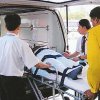Where are the ambulances? – A Malaysian Doctor
It is surprising when one browse through the news regarding the blast in Bukit Bintang, one might notice there is absent mention of ambulances.
It is very unfortunate that a life was lost in the incident. However one must also analyse what are the factors that contribute to the lost of life.
In any trauma care management to the injured, healthcare authorities will look closely at death of a patient transferred from one healthcare facility to another.
The blast in Bukit Bintang may be a good case study. Why?
Every healthcare provider is familiar with the golden hour in trauma. Its the basis of trauma systems development in many country such as Singapore or Hong Kong.
The concept states that early appropriate intervention provided to a trauma patient provide survival chance.
What are early appropriate interventions? Namely early ambulance or Emergency Medical Services response, early assessment of severity of injuries and early transportation of the patient to the best health facility that can provide appropriate intervention for the injuries.
In Bukit Bintang, the nearest hospital will be Tung Shin but the appropriate hospital to treat the severely injured victims would be Hospital Kuala Lumpur.
The difference of time in absence of traffic congestion would be just five minutes. In the hands of trained "paramedics" in the ambulance, that extra five minutes is acceptable.
Furthermore looking at the inter-hospital transfer services in Malaysia, many district hospitals or even private centres can tell stories of the difficulties and hell they have to experience before getting major government hospitals to accept their patients.
The death should not be viewed as tragic lost of life but seriously investigated for failure of Emergency Response System in the country.
Bukit Bintang is the heart of tourism in the country and should have a world class response. So why did the public resort to using taxis to transport the patients?
Did the public not activate the 999 number? Or the ambulance from hospitals was just taking too long that the public just felt helpless waiting for it to arrive?
How about ambulance from Jabatan Bomba dan Penyelamat, the fire services would sure be activated to respond to the scene. They now boast to have ambulances escorting their trucks.
The Health Minister, director-general of health, the mayor of Kuala Lumpur, the emergency medicine and pre-hospital care head of services Malaysia must answer to the devoid of the ambulance response to the blast.
Perhaps now the Health Minister would empower taxi drivers to be first responders similar to his solution of for his personal experience delay in getting ambulance.
It is surprising when one browse through the news regarding the blast in Bukit Bintang, one might notice there is absent mention of ambulances.
It is very unfortunate that a life was lost in the incident. However one must also analyse what are the factors that contribute to the lost of life.
In any trauma care management to the injured, healthcare authorities will look closely at death of a patient transferred from one healthcare facility to another.
The blast in Bukit Bintang may be a good case study. Why?
Every healthcare provider is familiar with the golden hour in trauma. Its the basis of trauma systems development in many country such as Singapore or Hong Kong.
The concept states that early appropriate intervention provided to a trauma patient provide survival chance.
What are early appropriate interventions? Namely early ambulance or Emergency Medical Services response, early assessment of severity of injuries and early transportation of the patient to the best health facility that can provide appropriate intervention for the injuries.
In Bukit Bintang, the nearest hospital will be Tung Shin but the appropriate hospital to treat the severely injured victims would be Hospital Kuala Lumpur.
The difference of time in absence of traffic congestion would be just five minutes. In the hands of trained "paramedics" in the ambulance, that extra five minutes is acceptable.
Furthermore looking at the inter-hospital transfer services in Malaysia, many district hospitals or even private centres can tell stories of the difficulties and hell they have to experience before getting major government hospitals to accept their patients.
The death should not be viewed as tragic lost of life but seriously investigated for failure of Emergency Response System in the country.
Bukit Bintang is the heart of tourism in the country and should have a world class response. So why did the public resort to using taxis to transport the patients?
Did the public not activate the 999 number? Or the ambulance from hospitals was just taking too long that the public just felt helpless waiting for it to arrive?
How about ambulance from Jabatan Bomba dan Penyelamat, the fire services would sure be activated to respond to the scene. They now boast to have ambulances escorting their trucks.
The Health Minister, director-general of health, the mayor of Kuala Lumpur, the emergency medicine and pre-hospital care head of services Malaysia must answer to the devoid of the ambulance response to the blast.
Perhaps now the Health Minister would empower taxi drivers to be first responders similar to his solution of for his personal experience delay in getting ambulance.
source:the malaysian insider

